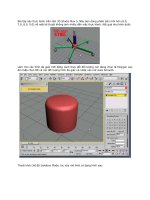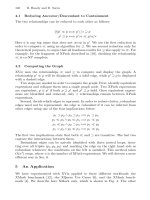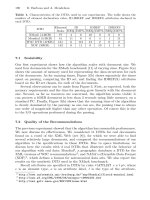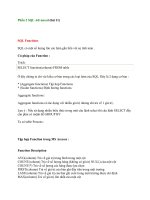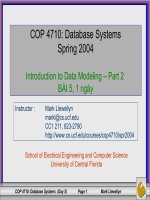Tài liệu Database Systems - Part 3 & 4 pptx
Bạn đang xem bản rút gọn của tài liệu. Xem và tải ngay bản đầy đủ của tài liệu tại đây (550.7 KB, 66 trang )
COP 4710: Database Systems (Day 4) Page 1 Mark Llewellyn
COP 4710: Database Systems
Spring 2004
Introduction to Data Modeling
BÀI 3&4, 2 ngày
School of Electrical Engineering and Computer Science
University of Central Florida
Instructor : Mark Llewellyn
CC1 211, 823-2790
/>COP 4710: Database Systems (Day 4) Page 2 Mark Llewellyn
•
A data model is an integrated collection of concepts for
describing and manipulating data, relationships between
data, and constraints on the data in an organization.
•
A model is a representation of “real world” objects and
events, and their associations. It is an abstraction that
concentrates on the essential, inherent aspects of an
organization and ignores accidental properties.
•
A data model must provide the basic concepts and notations
that will allow database designers and end-users
unambiguously and accurately to communicate their
understanding of the organizational data.
Data Models
COP 4710: Database Systems (Day 4) Page 3 Mark Llewellyn
•
A data model can be thought of as comprising
three components:
1. A structural part, consisting of a set of rules according
to which databases can be constructed.
2. A manipulative part, defining the types of operations
that are allowed on the data (this includes operations
that are used for updating or retrieving data from the
database and for changing the structure of the
database).
3. Possibly a set of integrity rules, which ensures that the
data is accurate.
Data Models (cont.)
COP 4710: Database Systems (Day 4) Page 4 Mark Llewellyn
•
Looking at the three level architecture, we can
identify three different, related data models.
1. An external data model to represent each user’s view
of the organization.
2. A conceptual data model to represent the logical (or
community view) that is DBMS independent.
3. An internal data model to represent the conceptual
schema in such a way that it can be understood by the
DBMS.
Data Models (cont.)
COP 4710: Database Systems (Day 4) Page 5 Mark Llewellyn
•
There have been many different data models
which have been theorized, utilized, developed,
and implemented over the years. They fall into
three broad categories: object-based, record-
based, and physical.
•
There are three principle record-based models:
the relational data model, the network data
model, and the hierarchical data model. Our
focus will be on the relational data model in this
course.
Data Models (cont.)
COP 4710: Database Systems (Day 4) Page 6 Mark Llewellyn
•
Semantic data models attempt to capture the “meaning” of a
database. Practically, they provide an approach for
conceptual data modeling.
•
Over the years there have been several different semantic
data models that have been proposed.
•
By far the most common is the entity-relationship data
model, most often referred to as simply the E-R data model.
•
The E-R model is often used as a form of communication
between database designers and the end users during the
developmental stages of a database.
Introduction to Data Modeling
COP 4710: Database Systems (Day 4) Page 7 Mark Llewellyn
•
The E-R model contains an extensive set of modeling tools,
some of which we will not be concerned with as our
primary objective is to give you some insight into
conceptual database design and not learning all of the ins
and outs of the E-R model.
•
Another conceptual modeling which is becoming more
common is the Object Definition Language (ODL) which is
an object-oriented approach to database design that is
emerging as a standard for object-oriented database
systems.
Introduction to Data Modeling
(cont.)
COP 4710: Database Systems (Day 4) Page 8 Mark Llewellyn
•
The database design process can be divided into six basic
steps. Semantic data models are most relevant to only the
first three of these steps.
1. Requirements Analysis: The first step in designing a
database application is to understand what data is to be
stored in the database, what applications must be built on
top of it, and what operations are most frequent and subject
to performance requirements. Often this is an informal
process involving discussions with user groups and
studying the current environment. Examining existing
applications expected to be replaced or complemented by
the database system.
Introduction to Data Modeling
(cont.)
COP 4710: Database Systems (Day 4) Page 9 Mark Llewellyn
2. Conceptual Database Design: The information gathered in
the requirements analysis step is used to develop a high-
level description of the data to be stored in the database,
along with the constraints that are known to hold on this
data.
3. Logical Database Design: A DBMS must be selected to
implement the database and to convert the conceptual
database design into a database schema within the data
model of the chosen DBMS.
Introduction to Data Modeling
(cont.)
COP 4710: Database Systems (Day 4) Page 10 Mark Llewellyn
4. Schema Refinement: In this step the schemas developed in
step 3 above are analyzed for potential problems. It is in
this step that the database is normalized. Normalization of a
database is based upon some elegant and powerful
mathematical theory. We will discuss normalization later in
the term.
5. Physical Database Design: At this stage in the design of a
database, potential workloads and access patterns are
simulated to identify potential weaknesses in the conceptual
database. This will often cause the creation of additional
indices and/or clustering relations. In critical situations, the
entire conceptual model will need restructuring.
Introduction to Data Modeling
(cont.)
COP 4710: Database Systems (Day 4) Page 11 Mark Llewellyn
6. Security Design: Different user groups are identified and
their different roles are analyzed so that access patterns to
the data can be defined.
•
There is often a seventh step in this process with the last
step being a tuning phase, during which the database is
made operational (although it may be through a simulation)
and further refinements are made as the system is
“tweaked” to provide the expected environment.
•
The illustration on the following page summarizes the main
phases of database design.
Introduction to Data Modeling
(cont.)
COP 4710: Database Systems (Day 4) Page 12 Mark Llewellyn
Introduction to Data Modeling
(cont.)
COP 4710: Database Systems (Day 4) Page 13 Mark Llewellyn
•
The E-R model employs three basic notions: entity sets,
relationship sets, and attributes.
•
An entity is a “thing” or “object” in the real world that is
distinguishable from all other objects. An entity may be
either concrete, such as a person or a book, or it may be
abstract, such as a bank loan, or a holiday, or a concept.
•
An entity is represented by a set of attributes. Attributes are
descriptive properties or characteristics possessed by an
entity.
•
An entity set is a set of entities of the same type that share
the same attributes. For example, the set of all persons who
are customers at a particular bank can be defined as the
entity set customers.
The Entity-Relationship Model
COP 4710: Database Systems (Day 4) Page 14 Mark Llewellyn
•
Entity sets do not need to be disjoint. For example, we
could define the entity set of all persons who work for a
bank (employee) and the entity set of all persons who are
customers of the bank (customers). A given person entity
might be an employee, a customer, both, or neither.
•
For each attribute, there is a permitted set of values, called
the domain (sometimes called the value set), of that
attribute. More formally, an attribute of an entity set is a
function that maps from the entity set into a domain. Since
an entity set may have several attributes, each entity in the
set can be described by a set of <attribute, data-value> pairs,
one for each attribute of the entity set.
•
A database contains a collection of entity sets.
The Entity-Relationship Model
(cont.)
COP 4710: Database Systems (Day 4) Page 15 Mark Llewellyn
E-R Model Notation
E
entity set
E
weak entity set
a
attribute
aa
multi-valued attribute
a
derived attribute
R relationship
R
identifying relationship
for a weak entity set
total participation of
entity set in relationship
E
R
E
R
partial participation of
entity set in relationship
att
primary key
COP 4710: Database Systems (Day 4) Page 16 Mark Llewellyn
E-R Model Notation (cont.)
1:1 cardinality from E1 to E2
attribute
discriminating attribute of
a weak entity set
E1
R
E2
E1
R
E2
1:M cardinality from E1 to E2
E1
R
E2
alternate form for 1:M cardinality from E1 to E2
1 M
E1
R
E2
M:1 cardinality from E1 to E2
E1
R
E2
M:M cardinality from E1 to E2
E1
R
E2
alternate form for M:M cardinality from E1 to E2
N M
COP 4710: Database Systems (Day 4) Page 17 Mark Llewellyn
E-R Model Notation (cont.)
ISA (specialization or generalization)(partial participation)
ISAISA
ISAISA
disjoint
Disjoint ISA (specialization or generalization)
ISAISA
Total generalization
COP 4710: Database Systems (Day 4) Page 18 Mark Llewellyn
E-R Model Notation (cont.)
Aggregation: box drawn around relationship
which is treated as an entity
E1
R
1
E2
E3
R
2
E4
R
E2
Structural constraint: (min,max) on the
participation of an entity in a relationship
(min,max)
COP 4710: Database Systems (Day 4) Page 19 Mark Llewellyn
Example E-R Diagram (ERD)
customer loan
borrower
customer-id
customer-name
customer-street
customer-city
customer-id
amount
COP 4710: Database Systems (Day 4) Page 20 Mark Llewellyn
Another Example ERD
customer
customer-id
customer-name street
apartment-num
phone-num
date-of-birth
age
first-name
middle-name
last-name
address
city
state
zipcode
street-name
street-num
COP 4710: Database Systems (Day 4) Page 21 Mark Llewellyn
•
As used in the E-R model, an attribute can be characterized
by the following attribute types:
•
Simple or Composite: A simple attribute contains no
subparts while a composite attribute will contain subparts.
For example, consider the attribute name. If name
represents a simple attribute then we must treat the first
name, middle name, and last name as an atomic, indivisible
attribute. On the other hand, if name represents a composite
attribute then we have the option of dealing with the entire
name as a whole or dealing only with one of the subparts.
For example, we could look only at last names, something
that we could not do with a simple attribute.
Attributes in the E-R Model
COP 4710: Database Systems (Day 4) Page 22 Mark Llewellyn
•
Single-valued or Multi-valued: A single-valued attribute
may have at most one value at any particular time instance.
A multiple-valued attribute may have several different
values at any particular time instance.
–
For example, consider a particular course at UCF. At any given
moment the number of students enrolled in that course is a single
value, say 100, but not 100, 80, and 45! On the other hand, some
attributes may contain different values at the same time instant.
For example, consider an attribute of the entity set student which
might be phone-number. At any given time instant a student may
have several different phone numbers and thus a multi-valued
attribute would be best to accurately model the student. It is also
common to place lower and upper bounds on the number of
different values that a multi-valued attribute may have at any
given time.
Attributes in the E-R Model (cont.)
COP 4710: Database Systems (Day 4) Page 23 Mark Llewellyn
•
Derived: This is an attribute whose value is
derived (computed) from the values of other related
attributes or entities.
–
For example, suppose that the bank customer entity set
contains an attribute loans-held, which represents the
number of loans a customer has from the bank. The
value of this attribute can be computed for each
customer by counting the number of loan entities
associated with that customer.
Attributes in the E-R Model (cont.)
COP 4710: Database Systems (Day 4) Page 24 Mark Llewellyn
•
Null: An attribute takes a null value when an entity does
not have a value for it. Null values are usually special cases
that can be handled in a number of different ways
depending on the situation.
–
For example, it could be interpreted to mean that the attribute is
“not applicable” to this entity, or it could mean that the entity has
a value for this attribute but we don’t know what it is. We will see
later in the term how different systems handle null values and the
different interpretations that may be associated with this special
value.
Attributes in the E-R Model (cont.)
COP 4710: Database Systems (Day 4) Page 25 Mark Llewellyn
•
A relationship is an association among several
entities.
–
For example, we can define a relationship that associates you
as a student in COP 4710. This relationship might specify
that you are enrolled in this course.
Relationships in the E-R Model
A relationship set is a set of relationships of the same type.
More formally, it is a mathematical relation on n ≥ 2 (possibly non distinct) entity sets.
If E
1
, E
2
, …, E
n
are entity sets, then a relationship set R is a subset of:
where is the relationship.
( )
{ }
nn2211n21
Ee,,Ee,Eee,,e,e ∈∈∈
( )
n21
e,,e,e

